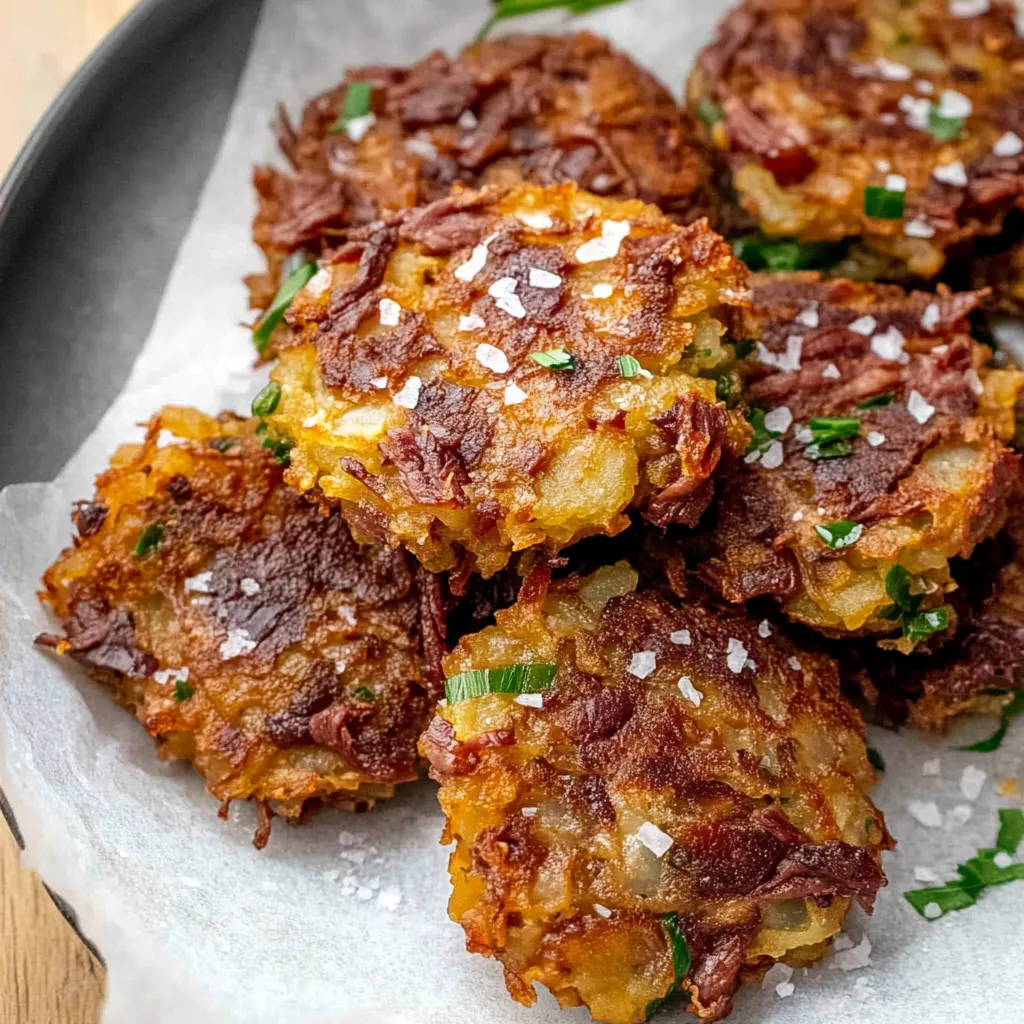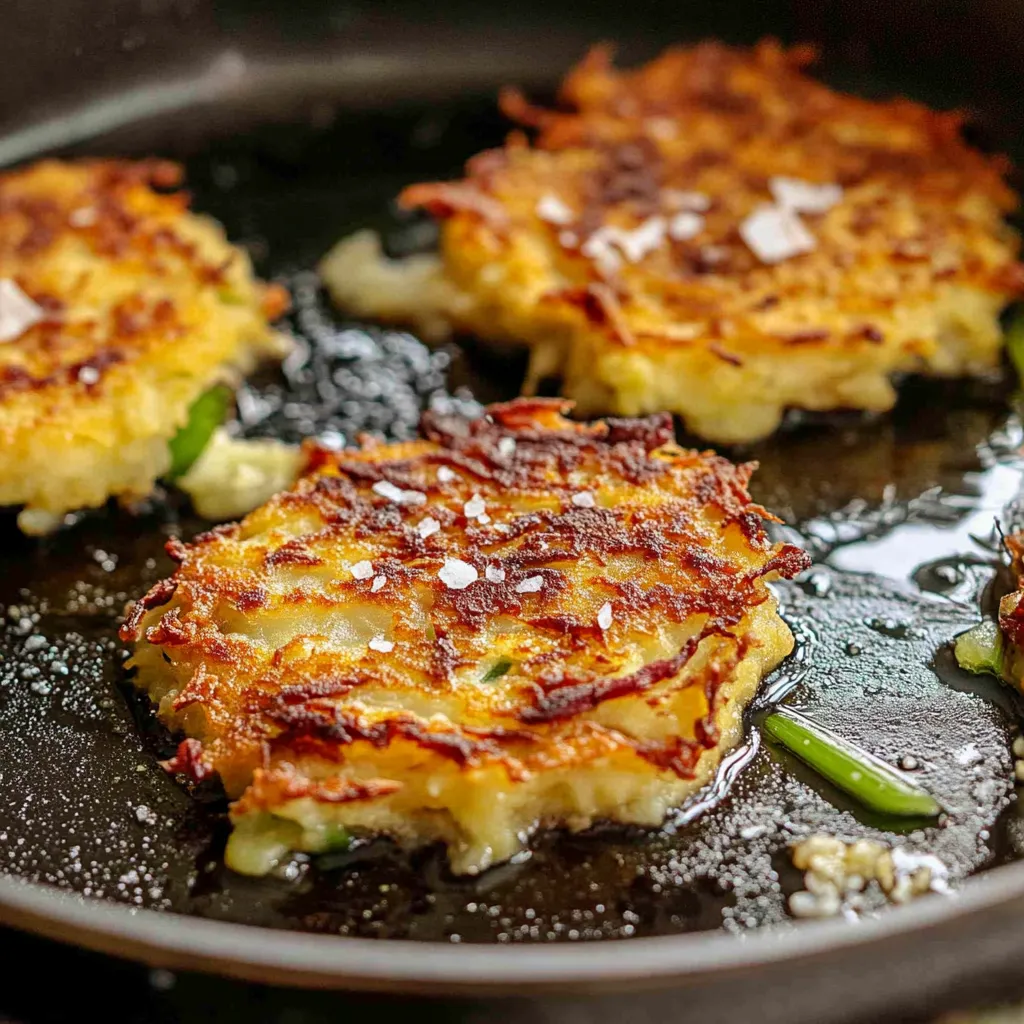 Pin it
Pin it
These incredibly crispy corned beef fritters transform leftover corned beef and simple potatoes into golden, crunchy patties that deliver all the satisfying flavors of corned beef hash but with an irresistibly crispy exterior that's impossible to achieve with traditional hash. The secret lies in using cornstarch instead of flour as a binder, which creates an incredibly crisp coating while the shredded potatoes provide a tender, creamy interior packed with chunks of flavorful corned beef. Unlike complicated breakfast recipes that require multiple steps and precise timing, these fritters come together quickly using ingredients you likely already have, making them perfect for using up St. Patrick's Day leftovers or creating a hearty weekend breakfast that feels special.
I created this recipe when I had leftover corned beef from St. Patrick's Day and wanted something more exciting than regular hash. The first time I bit into one of these fritters, the contrast between the incredibly crispy exterior and the soft, flavorful interior was exactly what I'd been craving. Now I actually look forward to having leftover corned beef because I know these amazing fritters are in my future.
Essential Ingredients and Selection Tips
- Russet potatoes: Choose large, firm potatoes without green spots; the high starch content helps bind the fritters and creates the best texture
- Quality corned beef: Leftover homemade corned beef provides the best flavor, but good deli corned beef works perfectly; avoid overly processed versions
- Fresh scallions: Select scallions with bright green tops and firm white bottoms; they add mild onion flavor without overpowering the beef
- Cornstarch: This is crucial for the signature crispy texture; potato starch can substitute but regular flour won't create the same crunch
- Fresh garlic: Use plump, firm cloves without green shoots; pre-minced garlic lacks the bright flavor needed for this hearty dish
- Quality frying fat: Combination of olive oil and butter provides the best flavor and browning; all oil works but won't taste as rich
The secret to perfect fritters is removing every possible drop of water from the shredded potatoes - this single step makes the difference between soggy and incredibly crispy results.
Detailed Step-by-Step Instructions
- Step 1: Prepare the potatoes properly:
- Peel the russet potatoes and shred them using the large holes of a box grater. Immediately place the shredded potatoes in the center of a clean kitchen towel, gather the corners, and twist to form a tight bundle.
- Step 2: Remove all moisture:
- Squeeze the potato bundle as hard as possible over the sink, continuing to twist and squeeze until no more water comes out. This is the most critical step - you should extract at least ¼ cup of liquid from 2 large potatoes.
- Step 3: Prepare the corned beef:
- Cut the corned beef into bite-sized chunks, roughly ½-inch pieces. Don't chop it too finely as you want substantial pieces in each fritter that provide texture and flavor bursts.
- Step 4: Combine the base ingredients:
- In a large mixing bowl, combine the squeezed potatoes, chopped scallions, minced garlic, beaten egg, salt, and pepper. Mix thoroughly until everything is evenly distributed and the egg coats all the potato shreds.
- Step 5: Add binding and beef:
- Sprinkle the cornstarch evenly over the mixture, then add the corned beef chunks. Fold everything together gently but thoroughly until no dry cornstarch is visible and the corned beef is evenly distributed.
- Step 6: Heat the cooking fat:
- In a large skillet over medium heat, heat the olive oil and butter until the butter stops foaming and the mixture is hot but not smoking. The fat should generously coat the bottom of the pan.
- Step 7: Form and cook fritters:
- Working quickly, scoop ¼-cup portions of the mixture and gently form into rough patties with your hands - they won't hold together perfectly, and that's normal. Carefully place in the hot fat, leaving space between each fritter.
- Step 8: First side cooking:
- Cook undisturbed for 3-5 minutes until the bottom is deep golden brown and crispy. Resist the urge to move them too early - they need time to develop that crucial crispy crust.
- Step 9: Flip and finish:
- Carefully flip each fritter using a spatula and cook the second side for another 3-5 minutes until equally golden and crispy. The fritters should be firm and golden brown on both sides.
- Step 10: Drain and season:
- Transfer cooked fritters to a wire rack and immediately sprinkle with flaky sea salt while they're still hot. Keep finished fritters warm in a 200°F oven while cooking remaining batches.
 Pin it
Pin it
The most important technique is maintaining proper heat throughout cooking - too high and the outside burns before the inside cooks, too low and they won't develop that essential crispy crust.
These fritters have become my favorite way to transform leftovers into something that feels completely new and exciting. My husband, who usually just tolerates leftover meals, actually gets excited when I mention making these because they taste so much better than regular reheated corned beef.
Understanding Potato Science and Moisture Control
The success of these fritters depends entirely on understanding how potatoes release moisture and how that affects texture during cooking. Raw shredded potatoes contain significant water that will create steam during cooking, preventing the crispy exterior from forming properly. The squeezing process removes this excess moisture while the salt in the mixture continues to draw out additional water, which is why the paper towel trick helps absorb ongoing moisture release. This moisture management is what creates the perfect contrast between crispy exterior and tender interior.
Starch Binding and Texture Development
Cornstarch works differently than wheat flour as a binding agent because it creates a crisper, more delicate coating when fried. The starch granules swell when heated, creating a crispy shell that's less dense than flour-based batters. Combined with the natural starches in russet potatoes, this creates a binding system that holds the fritters together while maximizing crispiness. The egg provides additional protein binding while contributing to browning reactions that develop flavor and color.
Heat Management and Frying Techniques
Proper temperature control is essential for fritters that are crispy outside and fully cooked inside. Medium heat allows the interior to cook through while the exterior develops the desired golden crust. Too high heat creates burned outsides with raw centers, while too low heat results in greasy, pale fritters that lack the signature crunch. The generous amount of fat ensures even heat distribution and proper browning while preventing sticking.
Flavor Integration and Seasoning Balance
Pre-seasoned corned beef provides a flavor foundation that eliminates the need for extensive seasoning while ensuring every bite is packed with taste. The scallions add mild onion flavor that complements rather than competes with the beef, while garlic provides aromatic depth. The salt helps draw moisture from potatoes while enhancing all flavors, creating a well-balanced final product that doesn't rely on heavy sauces or condiments.
Make-Ahead and Reheating Science
These fritters reheat exceptionally well because the cornstarch coating re-crisps when heated, unlike flour-based coatings that tend to become soggy. The key is using dry heat (oven or air fryer) rather than moist heat (microwave) to restore the original texture. Freezing works well because the structure is already set, and the reheating process can actually improve crispiness by driving off any residual moisture.
These corned beef fritters have taught me that some of the best recipes come from understanding how to take familiar flavors and present them in new ways that enhance rather than mask their essential character. Every time I make them, I'm reminded that good cooking often involves understanding the science behind techniques like moisture removal and proper frying, which allows you to create consistently excellent results that taste intentional rather than accidental.
Frequently Asked Questions
- → Can I use leftover corned beef for these fritters?
- Yes, leftover corned beef works perfectly. Just chop it roughly before mixing with the potato mixture.
- → Why do I need to squeeze water from the potatoes?
- Removing excess water helps the fritters hold together better and get crispier when cooked.
- → Can I make these fritters ahead of time?
- You can store cooked fritters in the fridge for 5 days. Reheat in a 350°F oven for 5-7 minutes to crisp them up.
- → What can I substitute for cornstarch?
- You can use regular flour instead of cornstarch, but cornstarch gives a crispier texture.
- → How do I know when the fritters are done cooking?
- Cook each side for 3-5 minutes until golden brown and crispy. The fritters should hold together when flipped.
- → Can I freeze these fritters?
- Yes, freeze cooked fritters for up to 3 months. Reheat from frozen in a 350°F oven until heated through.
